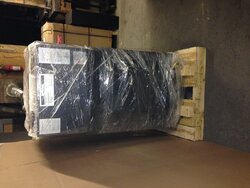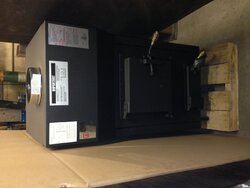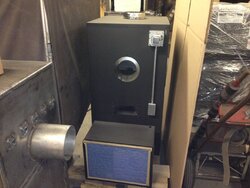I am new to the wood furnace market and am trying to educate myself to my options before I make any decisions but here is my deal: I am buying a new house that is a 3400 sq foot colonial with 3 floors of heated areas. The house is currently heated by a hot air oil furnace with 3 zones and heats the DW with an indirect water heater tied in. I have been looking into the Napolean HMF 200, Kumma 100 and the PSG Max Caddy . I'm not positive if I want to add-on the existing furnace or just do a full replacement. Can any of the aforementioned furnaces handle 3 different zones or are they just designed to heat one zone? What would you guys do?
Multi-zone furnace???
- Thread starter Jason762
- Start date
-
Active since 1995, Hearth.com is THE place on the internet for free information and advice about wood stoves, pellet stoves and other energy saving equipment.
We strive to provide opinions, articles, discussions and history related to Hearth Products and in a more general sense, energy issues.
We promote the EFFICIENT, RESPONSIBLE, CLEAN and SAFE use of all fuels, whether renewable or fossil.
You are using an out of date browser. It may not display this or other websites correctly.
You should upgrade or use an alternative browser.
You should upgrade or use an alternative browser.
- Status
- Not open for further replies.
maple1
Minister of Fire
The zoning is done with the ductwork, not the furnace itself.
Also not sure how an oil-fired hot air furnace would heat DHW - but I'm not all that familair with furnaces to start with.
I suspect you would want something besides wood - for backup heating? Therefore would want to leave the oil burner in place.
I have read nothing bad said about Kuumas. Or Caddys either, for that matter.
Also not sure how an oil-fired hot air furnace would heat DHW - but I'm not all that familair with furnaces to start with.
I suspect you would want something besides wood - for backup heating? Therefore would want to leave the oil burner in place.
I have read nothing bad said about Kuumas. Or Caddys either, for that matter.
Yes for backup I would either add the oil burner option onto the wood furnace or keep the existing furnace but that would require putting a new chimney in for the add-on wood furnace.The zoning is done with the ductwork, not the furnace itself.
Also not sure how an oil-fired hot air furnace would heat DHW - but I'm not all that familair with furnaces to start with.
I suspect you would want something besides wood - for backup heating? Therefore would want to leave the oil burner in place.
I have read nothing bad said about Kuumas. Or Caddys either, for that matter.
The bottom line is will a PSG Max Caddy work with 3 separate thermostats?Yes for backup I would either add the oil burner option onto the wood furnace or keep the existing furnace but that would require putting a new chimney in for the add-on wood furnace.
brenndatomu
Minister of Fire
Nope. You would have to wire the other two thermostats to zone control dampers in the duct work. You have to remember, wood heat can't just be turned off once the fire is lit, so a certain amount of duct work area would have to remain "open" all the time.The bottom line is will a PSG Max Caddy work with 3 separate thermostats?
It may be easier/cheaper/better to just do the second chimney and leave the existing furnace. Do you have central air? You would want to leave the furnace for that, A coils don't like to be above wood fireboxes very much.
Just an FYI, I'd be wary of the Napoleons, I have seen VERY little positive reviews/remarks about them.
JustWood
Minister of Fire
I would never buy a dual fuel unit. I think they suffer efficiency.Yes for backup I would either add the oil burner option onto the wood furnace or keep the existing furnace but that would require putting a new chimney in for the add-on wood furnace.
STIHLY DAN
Minister of Fire
I would never buy a dual fuel unit. I think they suffer efficiency.
I agree.
AK13
Feeling the Heat
I would never buy a dual fuel unit. I think they suffer efficiency.
Interesting. How so? I assume you mean wood/oil. Not wood/electric since electric efficiency should be about 100% either way.
To the OP, you could probably get the 3 zones working with your wood furnace with some relay logic, but probably the best bet (what I'd do) is just eliminate the zoning. Burn wood and keep the whole house nice and toasty. Tough to say if that makes sense without understanding the zoning.
maple1
Minister of Fire
The bottom line is will a PSG Max Caddy work with 3 separate thermostats?
How does the oil furnace work with three different stats?
AK13
Feeling the Heat
How does the oil furnace work with three different stats?
My guess is just like a zoned boiler system but with dampers instead of valves. Three zone dampers. Each tstat calls the furnace to run and associated damper to open.
maple1
Minister of Fire
My guess is just like a zoned boiler system but with dampers instead of valves. Three zone dampers. Each tstat calls the furnace to run and associated damper to open.
So I'm wondering why heat distribution from a wood furnace couldn't be controlled the same way? Seems all the zone-related stuff is ducting & control related, and independant of what is generating the heat?
(Speaking from a non-experienced position...)
Buzz Saw
Minister of Fire
So I'm wondering why heat distribution from a wood furnace couldn't be controlled the same way? Seems all the zone-related stuff is ducting & control related, and independant of what is generating the heat?
It can be, just as long as one zone is always open for a place for the heat to go(assuming the blower fan is running). Heck you could add a 4th zone and dump the heat into the basement to warm the floors if the other 3 zones are not calling for heat.
STIHLY DAN
Minister of Fire
I use balancing dampers, there is always heat coming out of the unit, and the house is always losing heat. I can keep 2 upstairs bedrooms at a constant 68, The main floor 70, and the basement 66. If I want the basement warmer I just open the damper a little. 1 bedroom wasn't getting enough heat and I thought I was going to install a fan in a can. I took that 1 particular damper out and with that slight less restriction got the added flow I needed.
Thanks for all the replies. Now my choice seems to be narrowed down to either adding on a Kuuma 100 onto the existing system or going with a PSG max caddy with oil burner add-on and replacing the existing oil furnace/indirect water heater and switching to an electric water heater for my domestic water. One big issue I may run into with the wood furnace add-on is lack of space in the mechanical room as well as difficulty in being able to add a Class A chimney to the house. Opinions???
OK so I moved into the new house. Here is the current set-up. It is a forced hot air system heated by a boiler with a heat exchanger in the air handler. There is a central air A coil. The domestic water in heated by an indirect water heater. There is sufficent space in the mechanical room for an add-on furnace and there is also an unused flu nearby. The house is 3400 sq. ft and pretty well insulated. There are 3 zones controlled by a Honeywell Minizone controller which leaves all zones open when no heat is running and then closes the zones which are not calling for heat when one of the zones is requesting heat. Bottom line is there is always an open zone so the heat from a solid fuel burner has some place to go. My current thinking has me going with the Kuuma VF100 and switching out the indirect water heater to a HPHWH. How does this sound? Any better suggestions?
STIHLY DAN
Minister of Fire
Sounds perfect, but keep the indirect water heater as a tempering tank to the Kuuma. Might as well take advantage of free hot water as well.
Please explain to me what you mean by using the indirect as a tempering tank...Sounds perfect, but keep the indirect water heater as a tempering tank to the Kuuma. Might as well take advantage of free hot water as well.
lampmfg
Burning Hunk
OK so I moved into the new house. Here is the current set-up. It is a forced hot air system heated by a boiler with a heat exchanger in the air handler. There is a central air A coil. The domestic water in heated by an indirect water heater. There is sufficent space in the mechanical room for an add-on furnace and there is also an unused flu nearby. The house is 3400 sq. ft and pretty well insulated. There are 3 zones controlled by a Honeywell Minizone controller which leaves all zones open when no heat is running and then closes the zones which are not calling for heat when one of the zones is requesting heat. Bottom line is there is always an open zone so the heat from a solid fuel burner has some place to go. My current thinking has me going with the Kuuma VF100 and switching out the indirect water heater to a HPHWH. How does this sound? Any better suggestions?
Sounds like a good decision! Shipping out both a Kuuma 100 and 200 today.
Attachments
STIHLY DAN
Minister of Fire
Getting the hot h2o coil with the Kuuma, plumbing it into your indirect so as you are burning you are making hot h2oin the indirect (tempering tank) then when you use hot h2o you will be supplying warm/ hot water to the hot water heater.Please explain to me what you mean by using the indirect as a tempering tank...
rsw1177
New Member
I'm curious of this as well. I currently have a 2 zone system, 1st zone is basement and 1st floor, 2nd zone is 2nd floor. My thought was to manually open the electronic dampers and heat the whole house with a Kuuma VF 100.
My question.... Will the fan from the Kuuma adequately push enough CFM to heat the house? House is roughly 3000 sq ft.
My question.... Will the fan from the Kuuma adequately push enough CFM to heat the house? House is roughly 3000 sq ft.
lampmfg
Burning Hunk
I'm curious of this as well. I currently have a 2 zone system, 1st zone is basement and 1st floor, 2nd zone is 2nd floor. My thought was to manually open the electronic dampers and heat the whole house with a Kuuma VF 100.
My question.... Will the fan from the Kuuma adequately push enough CFM to heat the house? House is roughly 3000 sq ft.
I don't think that would be a problem. If you need it we could go with the 1/2 hp instead of the 1/3 blower.
rsw1177
New Member
Are the CFM numbers on your website for the 1/3 hp blower, or are they for the 1/2 hp blower? If they are for the 1/3 blower, what are the numbers for the 1/2 hp blower?
lampmfg
Burning Hunk
1/3 and they are pretty much the same CFM and RPM. The only time we have really even used the 1/2 HP is when blowing down instead of up. It gives a slightly more power with less drag but it also uses a little more electricity. 1/3 HP is fine for 95% of all our customers.
STIHLY DAN
Minister of Fire
I'm curious of this as well. I currently have a 2 zone system, 1st zone is basement and 1st floor, 2nd zone is 2nd floor. My thought was to manually open the electronic dampers and heat the whole house with a Kuuma VF 100.
My question.... Will the fan from the Kuuma adequately push enough CFM to heat the house? House is roughly 3000 sq ft.
I am doing 2,800 sq ft and the 1/3 does fine, and that is in the low speed 95% of the time.
So I've had a slight change of plans. Due to my current setup it is much easier to replace the exisiting oil burner with a combination oil/wood unit instead of adding on a wood only unit. I am going to go with the PSG Max Caddy.
Here is my question: My installer told me the local shop has one wood only, Max Caddy left. He thinks we can take the Beckett burner out of my existing furnace and put it in the Max Caddy they have to make it a wood/oil unit. Does this sound possible? What are the other components I will need to add as well to make this work if it is even possible? The other option was to spend another $2000 to add the oil unit from the factory.
Here is my question: My installer told me the local shop has one wood only, Max Caddy left. He thinks we can take the Beckett burner out of my existing furnace and put it in the Max Caddy they have to make it a wood/oil unit. Does this sound possible? What are the other components I will need to add as well to make this work if it is even possible? The other option was to spend another $2000 to add the oil unit from the factory.
- Status
- Not open for further replies.
Similar threads
- Replies
- 61
- Views
- 5K
- Replies
- 5
- Views
- 556
- Replies
- 2
- Views
- 546
- Replies
- 6
- Views
- 980




